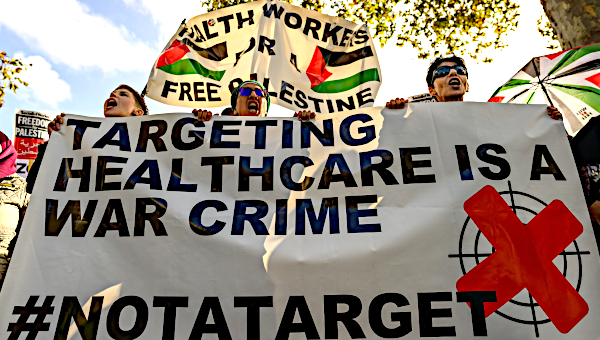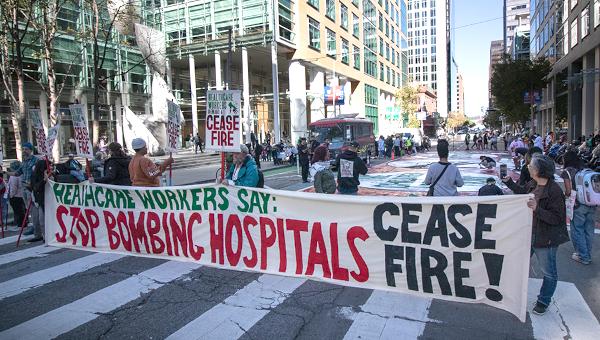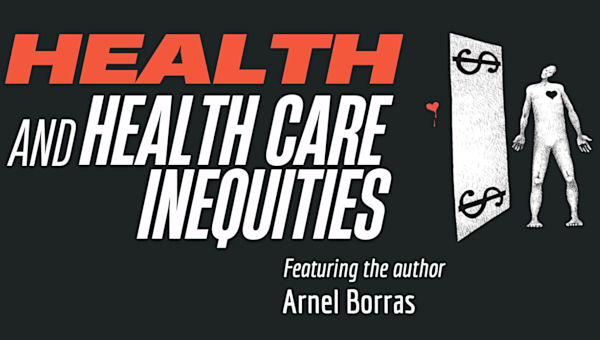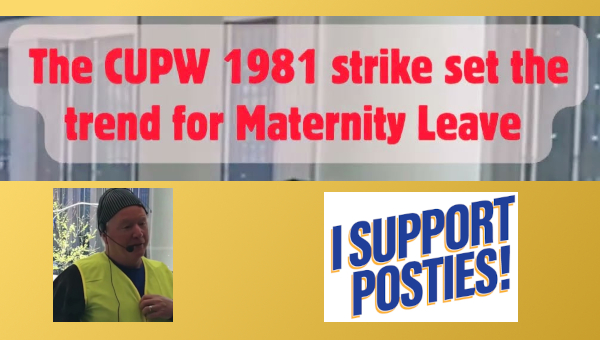Labour Leadership Squabbles in Ontario
As the capitalist crisis intensifies, austerity measures against public sector workers continue to mount. In Ontario, another round of cuts will soon be proposed by the Commission on the Reform of Ontario’s Public Services, headed by Don Drummond. Still, some Ontario labour leaders prefer to fight each other than the bosses. In some respects, inter-union solidarity in Ontario has reached an all-time low. A large public sector union is leaving the 700,000 worker Ontario Federation of Labour (OFL). Why is this happening at this time when international working-class forces opposing capitalism are attempting to regroup to combat the austerity agenda sweeping across capitalism?

Fighting Neoliberalism Under Harris – The Days of Action
In the fightback against the Harris cuts (which were being prodded at the time by the radical turn by the federal government of Jean Chretien to neoliberalism, and also engineered by then federal civil servant Don Drummond), unions and community partners formed a powerful movement that led to the so-called Ontario Days of Action. The Days of Action featured roving general strikes in a dozen cities over a two year period. It helped keep capitalist government attacks in check. It also united the labour movement and strengthened local membership through participation in fightback and solidarity.
The Days of Action solidarity eventually reached an impasse through union insularity, rivalry and leadership rejection of militancy. But they played a major role in putting a brake on the Harris agenda, and warning subsequent governments of the labour unrest and economic turmoil that could follow. Though the struggle against private and public sector employers continued to increase and collective agreement strength diminished over the following decade, inter-union activity and co-operation outside of parliamentary lobbying, has been rare. Despite often good localized labour council campaigns in Ontario, notably some of the strike support work in Sudbury, Ottawa and Toronto, cross-union picket support is more the exception than the rule.
The country’s largest industrial union, the Canadian Auto Workers (CAW) was excluded from the OFL over the last decade over the issue of raiding (a real problem, but one that is pervasive across the entire Canadian union movement without sanction or seeming purpose in how policy is being implemented). Historically, the CAW had a reputation of militancy and opposition to capitalist demands for concessions, and there was some division with it and other unions over policy and political action. Neither is really the case anymore, and in 2011 the CAW rejoined the OFL.
The OPSEU Split
Ironically, 2011 was the same year the leadership of the 125,000 worker Ontario Public Service Employees Union (OPSEU) decided to author another split. Many trade unionists are concerned that another crack in the house of labour could be more detrimental. How has this come about?
OPSEU has been withholding dues from the federation since 2010 after current OFL President Sid Ryan, former Ontario head of the Canadian Union of Public Employees (CUPE), was first elected. In the last two years the OFL executive has been dysfunctional with bitter rancour between Ryan and sisters Marie Kelly (Steelworkers), the former Secretary-Treasurer, and Terry Downey (OPSEU), the former Executive Vice-President. From the point of view of OPSEU leaders their move was all about the malfeasance of Ryan. But a political analysis reveals a more complicated picture.
Turf wars are one major contradiction separating union bureaucrats. This divisive tactic of withholding dues has its roots as far back as 2005 in OPSEU’s support of its sister Manitoba Government Employees Union (MGEU) against raiding at the Manitoba Lottery Corporation. Their parent body, the National Union of Public and General Employees (NUPGE) protested to the Canadian Labour Congress (CLC), the umbrella body for 3 million unionized Canadian workers. NUPGE withheld dues to the CLC which briefly resulted in the suspension of its provincial affiliates, including OPSEU, in 2008. NUPGE President James Clancy went on a national crusade over the issue of raiding, further withheld CLC dues and threatened to pull out of the Congress prior to the 2011 CLC convention. Fortunately, an agreement between leaders to restrain raiding headed off a national split.
Though Clancy backed down nationally, OPSEU President Smokey Thomas was inspired to resume Clancy’s divisive tactics to punish the OFL. To the chagrin of many OPSEU activists, including myself, virtually the entire union executive board voted to leave the OFL. (This will be subject to debate at the spring 2012 annual OPSEU Convention). The leadership seemed unable or unwilling to recognize the implications for union solidarity, particularly in this period of employer aggression toward public section unions. Political divisions between union officials, though less apparent than turf wars, underlie this split.
OPSEU and Political Divisions in Ontario Labour
Support for Canadian social democracy and the New Democratic Party (NDP) has been a defining feature of Canadian labour. Union officials in Canada have focused their political efforts on reforming the capitalist system via support for the NDP. With the incorporation of social democracy within the global onslaught of neoliberalism, and the ideological and organizational re-alignment of social democracy internationally and in Canada, the leadership of Canadian unions – and especially those centred in the industrial heartland of Ontario – have been in disarray.

It is apparent that former partnerships between capitalists, their governments and the labour leadership bear little or no fruit anymore. In Europe and the Canadian provinces, these governments implement austerity and defend the banks. They seldom even implement the most minimal legislation to facilitate union organizing; and they increasingly centre their political campaigns on anti-tax policies. The legacy of both the NDP provincial government and the NDP-centred progressive Council of former Toronto Mayor David Miller were calls for union restraint that reinforced neoliberal policies and split progressive voting blocs. Moreover, both regimes opened space in the subsequent political disillusionment for the far right regimes of Mike Harris and current Toronto Mayor Rob Ford. With the Ontario NDP remaining on the political margins, and even in a minority government situation being strategically directionless, some Ontario unions have found it practical to make deals with the provincial Liberal government. This is notably the case for some of the teachers’ unions, CAW, many unions in the construction trades.
In 2010, the McGuinty government brought in legislation for a public sector wage freeze. They proceeded to implement it through labour negotiation rather than just imposing legislation to nullify existing Collective Agreements. OPSEU’s Thomas took the bait. He was enthusiastic to collaborate with the Liberal wage freeze to the point of proposing framework agreements for expiring contracts. The first negotiated wage freeze was with the OPSEU property assessors whose members regarded it as a big sellout.
Politically, OPSEU has supported Liberal as well as NDP candidates at election time. In this respect, OPSEU leans to the right wing of the OFL. OPSEU and a minority of other affiliates have showed support for the Liberals. Most OFL affiliates more consistently show support for the NDP. OFL President Sid Ryan himself has run as a NDP candidate. OPSEU leaders with a few allies have been unable in the last two OFL elections to oppose effectively Ryan and support his rivals Kelly and Downey. Consequently they decided to withdraw from participation and weaken solidarity within the labour federation. The re-entry of the CAW, which shored up the organization, is a big political boost to Ryan, although in terms of electoral politics the CAW also has ties to the McGuinty government (somewhat embarrassingly pluming for McGuinty at a variety of election rallies last fall).
It remains to be seen whether the OFL will get over the infighting and effectively challenge the austerity measures. Though the labour movement in Ontario has not been able to capture the public’s imagination since the Days of Action, they have recently provided logistical support to the Occupy movement (which has had broad popularity across the province if little organizational capacity). The fightback is heating up in Ontario. In the private sector, there is broad resistance to the U.S. Caterpillar lockout and their demand to cut CAW wages in half in London. The OFL organized a significant rally in London, with Occupy London, in support of the CAW workers locked-out. In the public sector, Toronto city CUPE workers expect to be locked out themselves in February over privatization and 1,100 job cuts. They have united with broad community coalitions, like Save Our Libraries, Respect Toronto, Good Jobs for All Coalition, and Toronto Stop the Cuts, which have slowed down the cuts sought by millionaire Mayor Rob Ford. But it is hard to underscore enough how tentative these efforts have been, and the lack of political leadership and strategic thinking coming from any quarter of the Left in Ontario.
More Austerity to Come
The backdrop for capitalist austerity in Ontario is the Drummond Commission, due to report in February. There have been no public consultations by the Commission just meetings with select interest groups, as it has carefully managed the propaganda process, with aid from the mainstream press, in support of the need for austerity. Drummond is preparing to recommend to the Ontario government draconian public service cuts, particularly targeting healthcare, social transfers and privatization. The Ministry of Finance will release the measures they decide on in the Spring 2012 Budget, scheduled for March, and following on what is projected to be a severe federal budget from the Harper government.
This is a bad time for organizational splits in the labour movement, when the stakes are so high, the political differences so minimal, and strategic thinking so barren. These are splits over the narrowest of tactics for the most opportunistic reasons by labour leaderships even willing to make the case before their own members. Young workers who have been marginalized in the lean and mean neoliberal economy will be pivotal to revitalizing the union and social justice movements in Ontario and Canada. But it will take activists from a lot of quarters, from across many generations, to build a new anti-capitalist pole in Ontario politics. •
Reference Links:
La Botz, Dan. “Ontario’s ‘Days of Action’: Citywide Political Strikes,” in Troublemaker’s Handbook.
OPSEU Solidarity Group.wordpress.com.
Shaul, Gary. “The Labour Movement is OPSEU’s Home.”





